All eyes are on the news on Election Day as votes are tallied to determine whether President Donald Trump gets four more years in the White House or former Vice President Joe Biden returns to the Oval Office as president.
This year, media coverage may be more critical than ever as an explosion of mail-in voting makes it more likely the tallying will extend days, or longer, beyond election night. We’re documenting notable coverage here throughout the day.
See something we should know about? Send tips to news@poynter.org.
So, you might ask, how did President Trump perform well enough in Miami-Dade County to likely win the state of Florida? He appears to have done really well with Latinos.
And why is that? CBS News’ María Elena Salinas explained: “The president’s law and order and anti-socialism messages appear to be resonating with Cuban voters and also with voters from countries like Nicaragua, Venezuela, among others.”
— TOM JONES, Poynter Senior Writer (8:45 p.m. Eastern)
Interesting analysis from NBC’s Chuck Todd as it appears Joe Biden is in trouble in Florida because of what is happening in Miami-Dade County — where Biden likely will win, but not nearly by as much as Hillary Clinton did in 2016. And, to note, Trump still barely won Florida in 2016.
Florida is often considered the bellwether for the country, but maybe not in this case.
“Miami is its own deal,” said Todd, who is from Miami.
As Todd explains, the East Coast of Florida is like the Northeast of the United States and the West Coast of Florida is like the Midwest of the country. So Todd theorized that if Biden is looking for a silver lining, Biden has outperformed Clinton in the rest of the state. And that might give an indication that Biden will outperform Clinton in other parts of the country, such as Michigan, Wisconsin and, potentially, Pennsylvania.
— TOM JONES, Poynter Senior Writer (8:20 p.m. Eastern)
The news media plays a central role in calling U.S. elections. Poynter helps you make sense of all that coverage. Support our media reporting here.
Here you go:
The New York Times gives you a gentle rain, a dog you can virtually pet, a creepy cartoon, and some space videos that they must have found sitting around the science writers’ desks. You can feed sheep or watch a bird steal stuff on the beach. It is all just perfect for 2020.
— AL TOMPKINS, Poynter Senior Faculty (8:17 p.m. Eastern)
Scribit drawing robots at The Washington Post have outlined the 50 states and marked out the votes needed for President Trump or Joe Biden to reach an electoral college victory. As the winner in each state is determined, the livestream will show it turn red or blue.
It’s surprisingly soothing to listen to the whirring the machine makes as it crisscrosses the paper.
In 2016, The Post used 3D printers to create two White Houses — one in red, the other in blue. When the votes were counted, a fully rendered White House appeared in red.
— DORIS TRUONG, Director of Training and Diversity (7:40 p.m. Eastern)
And we’re off. Just a few moments after 7 p.m., the major networks kicked off their election night coverage and, already, CBS News’ Gayle King has the early line of night:
“People are tired,” King said. “They just want it to be over — spelled O-V-A-H!”
— TOM JONES, Poynter Senior Writer (7:18 p.m. Eastern)
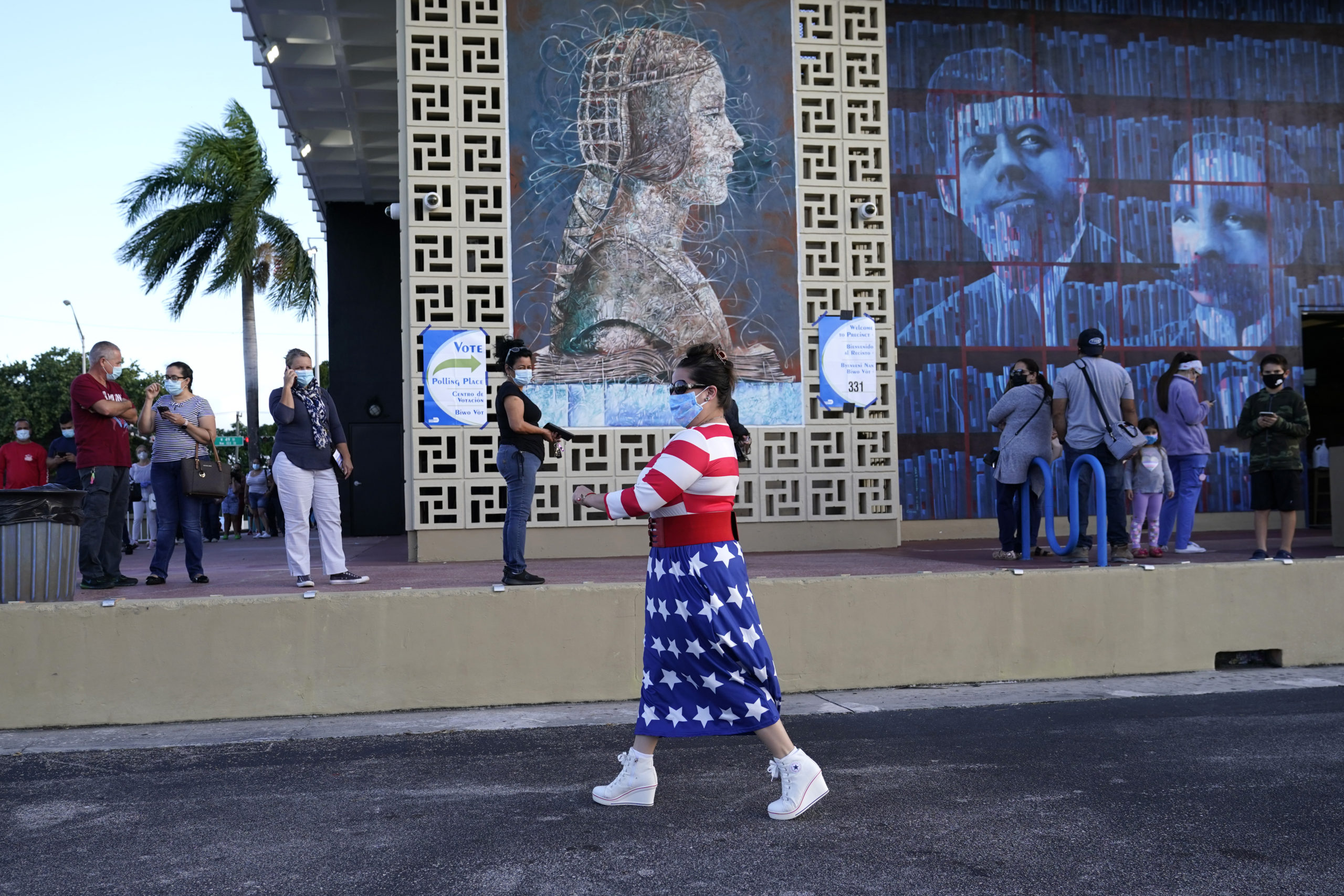
Yanitza Martinez wears red, white, and blue as she arrives to vote outside of the John F. Kennedy Library during the general election, Tuesday, Nov. 3, 2020, in Hialeah, Fla. (AP Photo/Lynne Sladky)
National news organizations will certainly cover the swing states tonight. But the best coverage often comes from local organizations based in those states. We put together a list of some of the newsrooms to follow. We’ve included newspapers, public radio and digital sources. You can also follow these newsrooms on our Twitter list.
— KRISTEN HARE, Editor of Locally and AMARIS CASTILLO, Poynter Contributor (6:37 p.m. Eastern)
The head of TEGNA’s news division sent a memo to all of the groups’ news executives today:

(TEGNA)
What do you say to your team working from coast-to-coast on such a historic day?
— AL TOMPKINS, Poynter Senior Faculty (6:29 p.m. Eastern)
Want to see more diversity in who reports on politics? Poynter coaches hundreds of women and journalists of color to be leaders in their news organizations each year. Support all of our diversity, equity and inclusion training programs here.
If the election results do not determine a winner in the presidential race tonight, local TV stations will have tough decisions to make about when and whether to air their early morning news programs.
“We have to be there for our viewers/users no matter what time it is — so we are ready and staffed for all hours of the night/morning,” Tracey Rogers, vice president and general manager for WKRN-TV in Nashville, told Poynter. “From my perspective, this is going to be a national story. If we don’t have a decision, we may be in national coverage through the morning hours and I’m OK with that since our viewers/users will be focused on the presidential race.
“If network coverage runs past 4 a.m. Central, we will produce and livestream our local newscasts and stick with network until it makes sense to break away. It will be an hour-by-hour decision-making process with lots of communication with our network.”
Ellen Crooke, vice president for news at TEGNA, told Poynter that the local TV stations’ web operations will be working throughout the night, anticipating a morning user surge.
“People will go to bed and need the latest numbers and information,” she said. “They will want answers: Who won? How close? How is my city? Was there violence? If no winner yet, what happens next?”
Read more about how local TV stations will handle late results here.
— AL TOMPKINS, Poynter Senior Faculty (6:26 p.m. Eastern)
David Begnaud, lead national correspondent for CBS This Morning, reports:
My phone just rang. Spokesperson for the Puerto Rico elections commission said: “the last 45 minutes have been crazy,” the webpage for results crashed because so many people are trying to access it.
I thought to myself, for Puerto Rico, the last 4 YEARS have been crazy.
— David Begnaud (@DavidBegnaud) November 3, 2020
— AL TOMPKINS, Poynter Senior Faculty (6:09 p.m. Eastern)
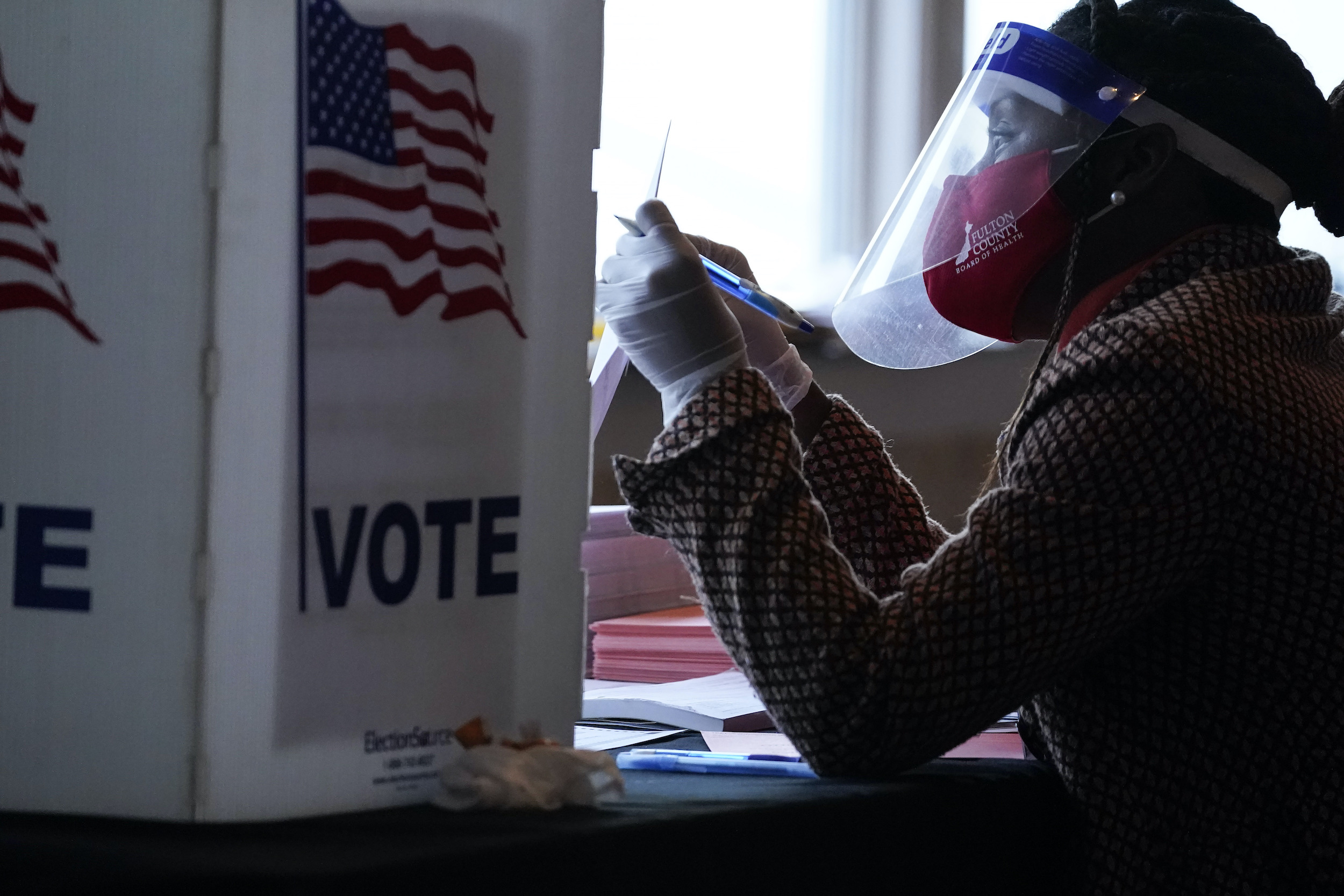
A poll worker talks to a voter before they vote on a paper ballot on Election Day in Atlanta on Tuesday, Nov. 3, 2020. (AP Photo/Brynn Anderson)
Photojournalists took to the streets this Election Day knowing they would register unforgettable images. Voting for president during a pandemic is a brand new situation. It requires masks, face shields, gloves, social distancing and, in some places, a curbside voting system.
See more very 2020 photos from the presidential election here.
— CRISTINA TARDÁGUILA, International Fact-Checking Network Associate Director (5:55 p.m. Eastern)
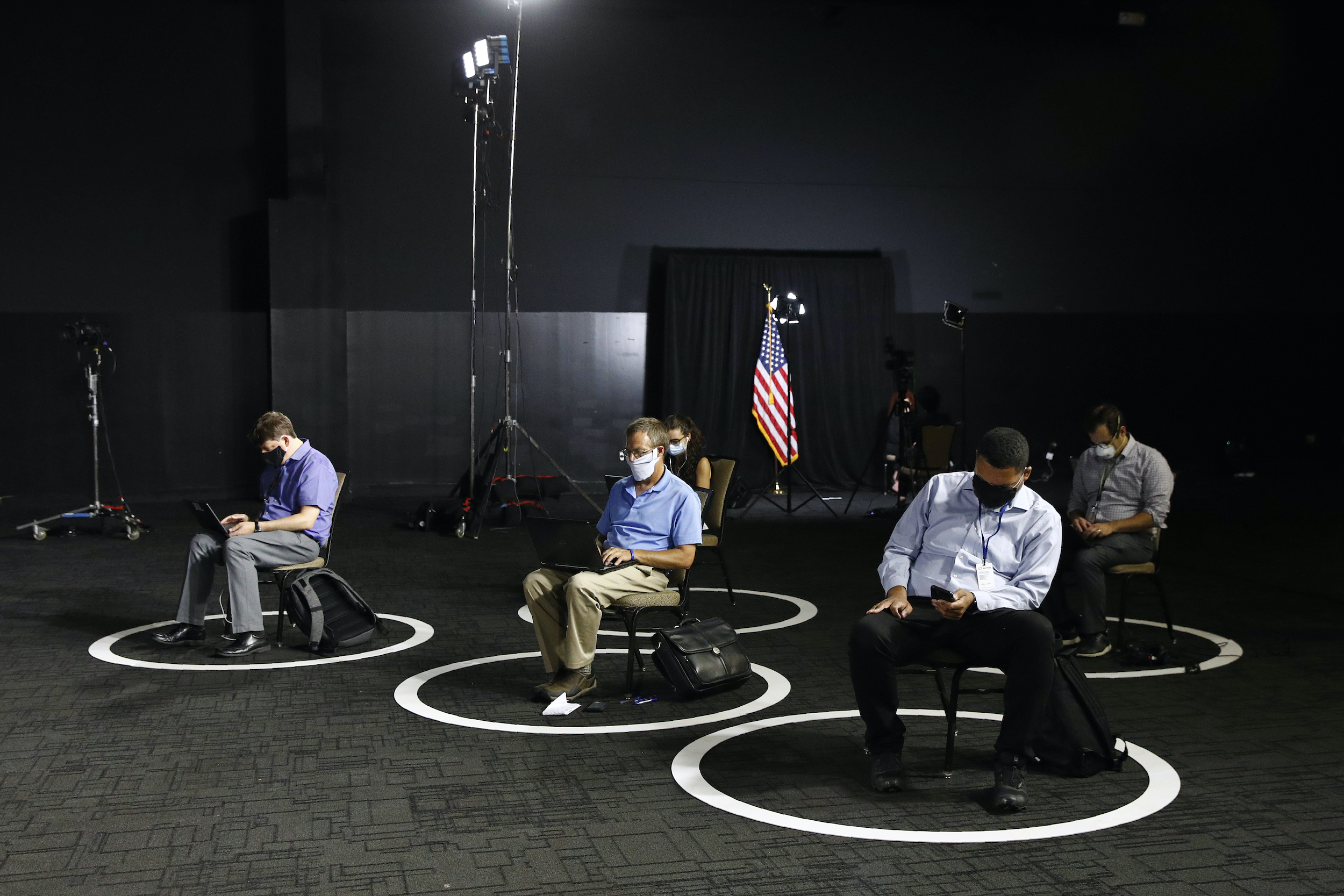
Reporters sit in socially-distant circles before a speech by Democratic presidential candidate, former Vice President Joe Biden, Tuesday, July 14, 2020, in Wilmington, Del. (AP Photo/Patrick Semansky)
Reporters who have been covering both candidates have one word to describe this election cycle: surreal.
Democratic candidates waived to non-existent crowds on livestreamed feeds. Donald Trump delivered daily and sometimes several-times-a-day media bashings and ridiculed reporters for wearing masks.
“By the end of the trail, large men were yelling at me to go away, and leave their president alone,” a female reporter told CNN’s Brian Stelter.
Stelter talked with a number of national campaign reporters for this story. He reported that “Trump beat reporters came to expect daily anti-Biden trolling by the campaign, followed by complaints from aides about why the media wasn’t playing along.”
“It’s hard to tell a source, ‘You guys are full of s—, so no one’s interested,’ but that was more or less the situation,” a White House reporter told Stelter.
The whole thing made reporters wonder if typical election beat coverage matters as much as they thought. CNN added:
Another member of the Biden press corps said the Democratic campaign was so low-key — and almost invisible on days without public events by the candidate — that assignment editors didn’t know how to frame the daily story of the campaign.
“Biden’s careful and light campaign schedule makes me wonder whether the thing we all focus our coverage on — the actual campaigning — is mostly irrelevant to presidential campaigns,” the reporter said. “Voters made their choice based on big dynamics that didn’t change much, namely a pandemic and recession, and rallies weren’t going to affect many votes.”
— AL TOMPKINS, Poynter Senior Faculty (5:34 p.m. Eastern)
Fox News host and conservative political commentator Sean Hannity tweeted out an article alleging that Rep. Ilhan Omar (D-Minn.) told Minnesota residents they don’t need to be registered to vote.
NOT A JOKE: Ilhan Omar Tells Residents ‘You Don’t Have to be Registered to Vote’ in Minnesota https://t.co/lC9uOW1B4J
— Sean Hannity (@seanhannity) November 3, 2020
Although it was included in the article, Hannity’s tweet and headline neglected to say that Omar was referring to same-day voter registration.
You don’t 👏🏾 have to 👏🏾 be registered 👏🏾 to go vote👏🏾 in Minnesota 👏🏾 we have 👏🏾 same day 👏🏾 registration 👏🏾 so you 👏🏾 can register 👏🏾 at the polls 👏🏾 https://t.co/iJGlm7Rgih 👏🏾
— Ilhan Omar (@IlhanMN) November 3, 2020
With all election coverage, it’s a good practice to read past the headline before sharing something on social media. Read multiple sources to get the full scope of a story.
In this case, a quick keyword search would have shown that many states, including Minnesota, offer same-day voter registration.
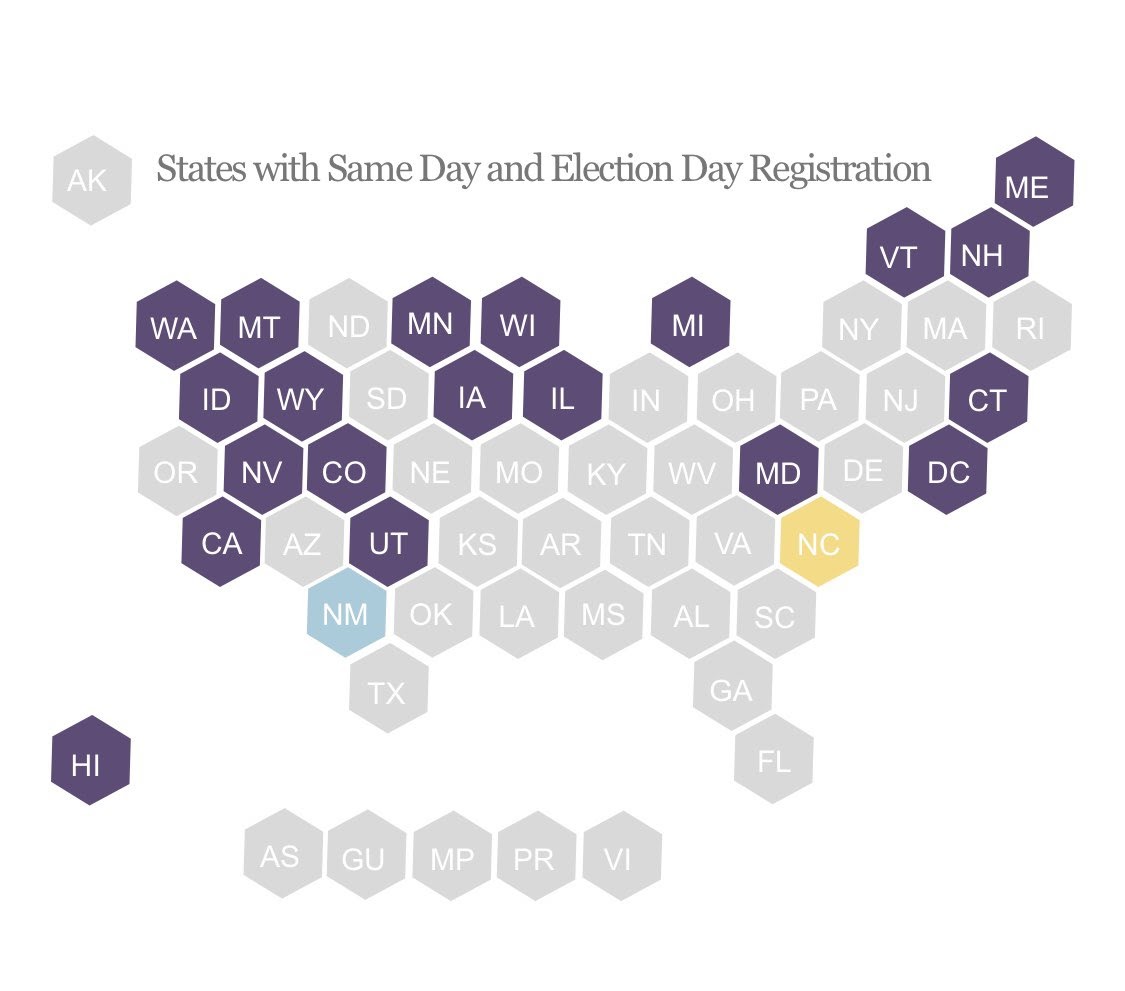
(Graphic from the National Conference of State Legislatures)
— ABBY VERVAEKE, MediaWise Intern (5:18 p.m. Eastern)
As the global capital of fact-checking — home to the International Fact-Checking Network, PolitiFact and MediaWise — Poynter leads the fight against online misinformation. Support our fact-checking and digital literacy efforts here.
Erica Stapleton of 12News Phoenix said there has been a run on some essential supplies around Phoenix, apparently linked to anticipation of election troubles, but it is not a widespread shortage.
A mixed bag at Phoenix grocery stores when it comes to essentials after some reports of people stocking up ahead of the election. We’ve seen some shelves empty, some fully stocked. #12News pic.twitter.com/53wUQJ7kP3
— Erica Stapleton (@EricaReportsAll) November 3, 2020
— AL TOMPKINS, Poynter Senior Faculty (4:58 p.m. Eastern)
Before primetime network news tonight, we’ll see election livestreams from a couple of nontraditional media sources.
From 4 p.m. to 8 p.m. Eastern, “The Daily” from The New York Times will broadcast an “experimental” Election Day livestream on iOS and on mobile web. Host Michael Barbaro and Carolyn Ryan, a deputy managing editor for The Times, will interview top editors and call up reporters covering the election across the country. Executive editor Dean Baquet and White House correspondent Maggie Haberman will be among the dozens interviewed. Viewers can watch on their phones.
Around 6:30 p.m. Eastern, two independent journalists and newsletter writers will host a climate-focused election livestream: Emily Atkin of HEATED and Eric Holthaus of The Phoenix. Guests will include NBC meteorologist John Morales, The New Republic’s Kate Aronoff and journalist David Sirota. Viewers can watch on HEATED’s YouTube channel.
— MEL GRAU, Poynter senior product specialist (4:52 p.m. Eastern)
Brittany M. Brown, who reports for Mississippi Today, recorded this video of what she described as a line of voters of at least a quarter-mile long.
Longest line I’ve seen this morning in Oxford at the Lafayette Civic Club. This precinct serves 5,162 voters. Line appears to be at least a quarter mile long, and it’s growing with a steady stream of voters. Cars are parked out to Highway 6. #MSElex pic.twitter.com/lFOTU5rXjY
— Brittany M. Brown (@isthatbritt) November 3, 2020
Miranda Cyr, a reporter for the Las Cruces Sun-News, snapped this photo of a long line inside a high school in Las Cruces, New Mexico.
Long lines at Oñate High School this morning as Las Cruces cast their ballots. Stay tuned for more reporting! @CrucesSunNews pic.twitter.com/15iJQr88ae
— Miranda Cyr (@mirandabcyr) November 3, 2020
That’s not the story everywhere, or even most places. Andrew Zhang, a reporter for The Daily Texan, a student newspaper, reported no lines at one of two voting locations on the University of Texas Austin campus. There was a line at the location this morning but it’s since thinned out.
I’m back at the FAC, where there is ~no line~. Half the machines in the polling place are unoccupied right now. pic.twitter.com/kDePptzB6p
— Andrew Zhang (@andrewczhang) November 3, 2020
Gabriella Borter, U.S. news correspondent for Reuters, reported no lines for those dropping off ballots at the Cuyahoga County Board of Elections Tuesday morning in Cleveland, Ohio.
The ballot drop off line at Cuyahoga County Board of elections this morning. There was no line of people like there has been for early voting in recent days- just cars dropping off some of the 243,000 absentee ballots that had still not been returned in Ohio as of last night pic.twitter.com/56f4nOgjq9
— Gabriella Borter (@gabriellaborter) November 3, 2020
— AMARIS CASTILLO, Poynter Contributor (3:59 p.m. Eastern)
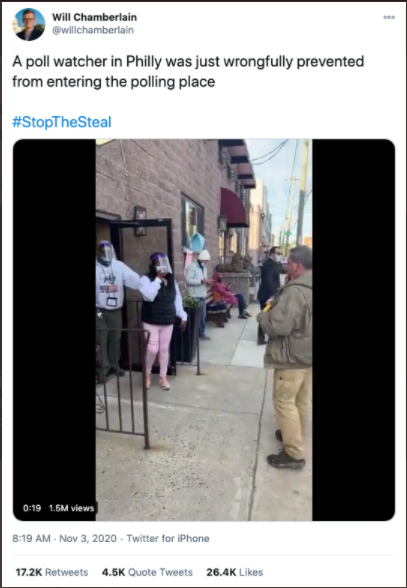
(Screenshot, Twitter)
The #StopTheSteal hashtag popped up prominently Tuesday morning after a video of a Trump election observer being denied entry to a polling place in Philadelphia went viral. Philadelphia City Commission spokesperson Kevin Feeley told ProPublica this was simply a case of confusion on the part of the poll worker, and the election observer had eventually been allowed entry to the polling place.
The use of the hashtag to inflate cases of human and technical error as voter fraud is a well-trod tactic according to Joan Donovan, research director for Harvard University’s Shorenstein Center on Media, Politics and Public Policy.
The hashtag first popped up in 2016 ahead of the Super Tuesday Republican primaries, accusing the Republican establishment of trying to stop then-candidate Donald Trump from winning the Republican Party’s nomination for president. It also saw heavy usage during the 2018 Florida recount of the governor and senate races, then accusing officials of trying to “steal” those elections for Democrats. They weren’t.
— HARRISON MANTAS, International Fact-Checking Network Reporter (3:54 p.m. Eastern)
In Chicago, Sharpies bleeding through ballots prompted concerns that votes could be invalidated. According to CBS Chicago station WBBM-TV, Chicago Board of Election officials confirmed Sharpies bleeding through will not impact the choices on the other side.
SHARPIE STRUGGLES:
Chicago Board of Election officials confirmed Sharpies bleeding through a ballot will not impact the choices on the other side.The back side of the ballot does not directly line up with the choices on the front. @cbschicago
— Megan Hickey (@MeganHickeyTV) November 3, 2020
“Voters who remain concerned can bring a ballpoint pen,” WBBM-TV reported.
— AMARIS CASTILLO, Poynter Contributor (3:43 p.m. Eastern)
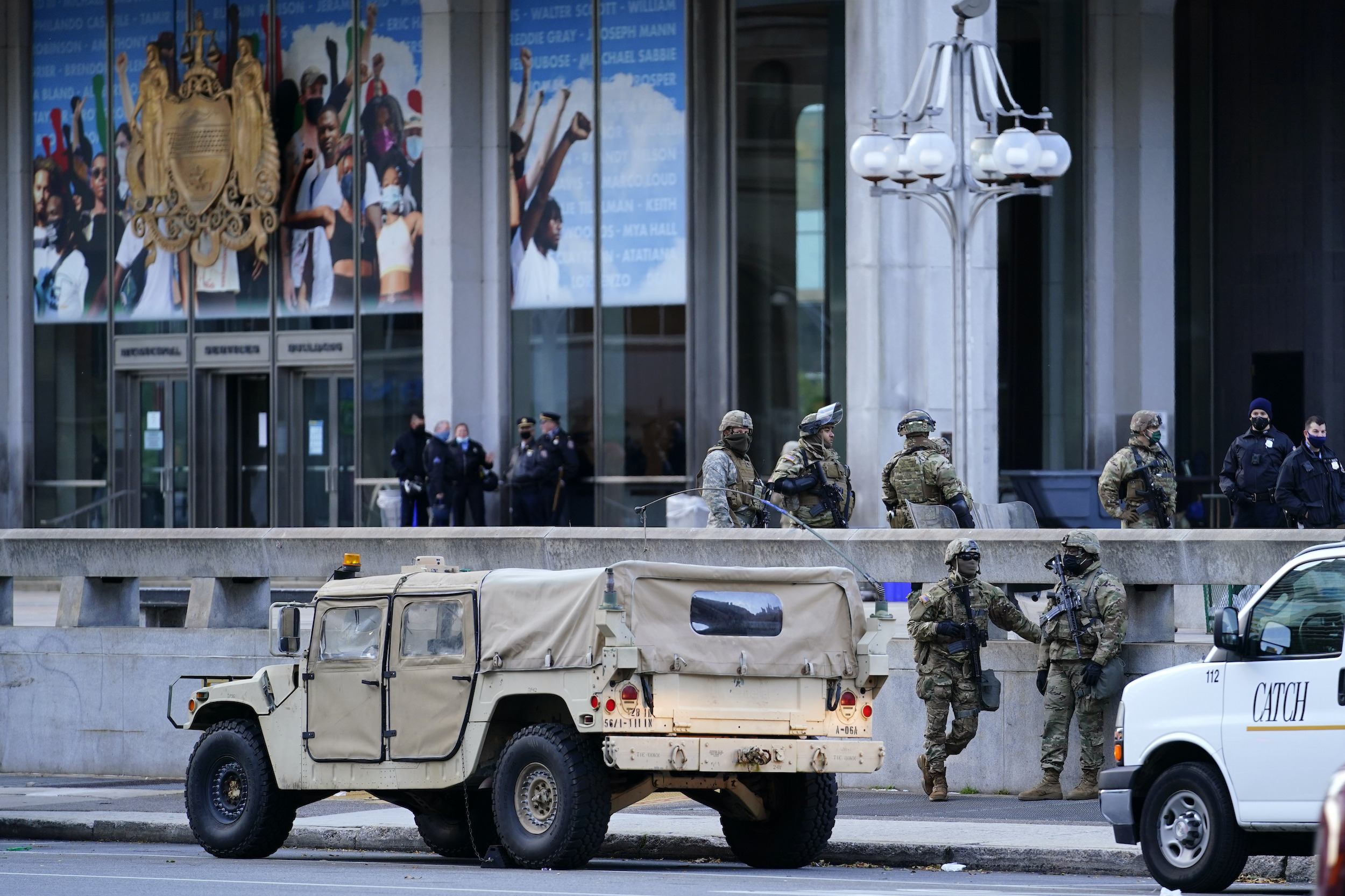
Members of the Pennsylvania National Guard and Philadelphia police officers stand outside the Philadelphia Municipal Services Building on the eve of the 2020 General Election in the United States, Monday, Nov. 2, 2020, in Philadelphia. (AP Photo/Matt Slocum)
Conspiracy theories didn’t take a break this Election Day. Lead Stories, a U.S-based fact-checking organization, had already debunked four of them before 2 p.m. Eastern. Please make sure you get your facts right and support fact-checkers.
It is false that the National Guard is only being activated in “Blue Cities” to prepare for possible violence. It’s happening in red states, too. According to Military Times, some 3,600 troops in 16 states have been deployed.
It is also false that the U.S Constitution allows a candidate to declare himself the winner. Lead Stories points out that a Facebook post and the tweet that went viral today are satirical.
The same organization emphasizes that there is no evidence that Democrats are colluding with the CIA to alter voting machines and that Twitter did not censor a tweet published by the Philadelphia GOP about “poll watchers.”
Before sharing any content, go to IFCN’s WhatsApp chatbot. #FactChat is available in English at hi.factchat.me and in Spanish at hola.factchat.me.
— CRISTINA TARDÁGUILA, International Fact-Checking Network Associate Director and LAURA WEFFER, FactChat’s editor (3:22 p.m. Eastern)
Tonight might be the weirdest election “night” ever. Poynter has been preparing both local and national journalists to cover it for months. Support our teaching team here.
Axios listed three phrases to understand tonight:
Red mirage and blue mirage describe how races look like they’ll unfold based on early ballots versus how they’ll actually play out.
Pre-bunking are efforts to preemptively show users accurate information to help them counter falsehoods later on.
Perception hacking:Facebook warned Tuesday that bad actors will falsely claim they’ve pulled off major hacks of electoral systems or seriously disrupted elections.
— AL TOMPKINS, Poynter Senior Faculty (3:02 p.m. Eastern)
Zach Cusson, a visual journalist on the investigative team at Newsy and E.W. Scripps Company’s D.C. Bureau, reports a pandemic-related voting issue:
I’m in James City County, VA and it appears that the spray being used to disinfect voting booths is causing the ballot machines to reject some ballots. These are then placed in a separate slot in the side of the machine. Election officials assure me those ballots ARE counted.
— Zach Cusson (@zcusson) November 3, 2020
The Des Moines Register is reporting similar issues in Iowa:
This is soooo 2020: Hand sanitizer gunking up counting machines https://t.co/F8XxnEvuaN via @DMRegister
— Kim Norvell (@KimNorvellDMR) November 3, 2020
— AL TOMPKINS, Poynter Senior Faculty (2:46 p.m. Eastern)
The New York Times is running a live map where people all over the United States are sharing in a few words what they are voting for.
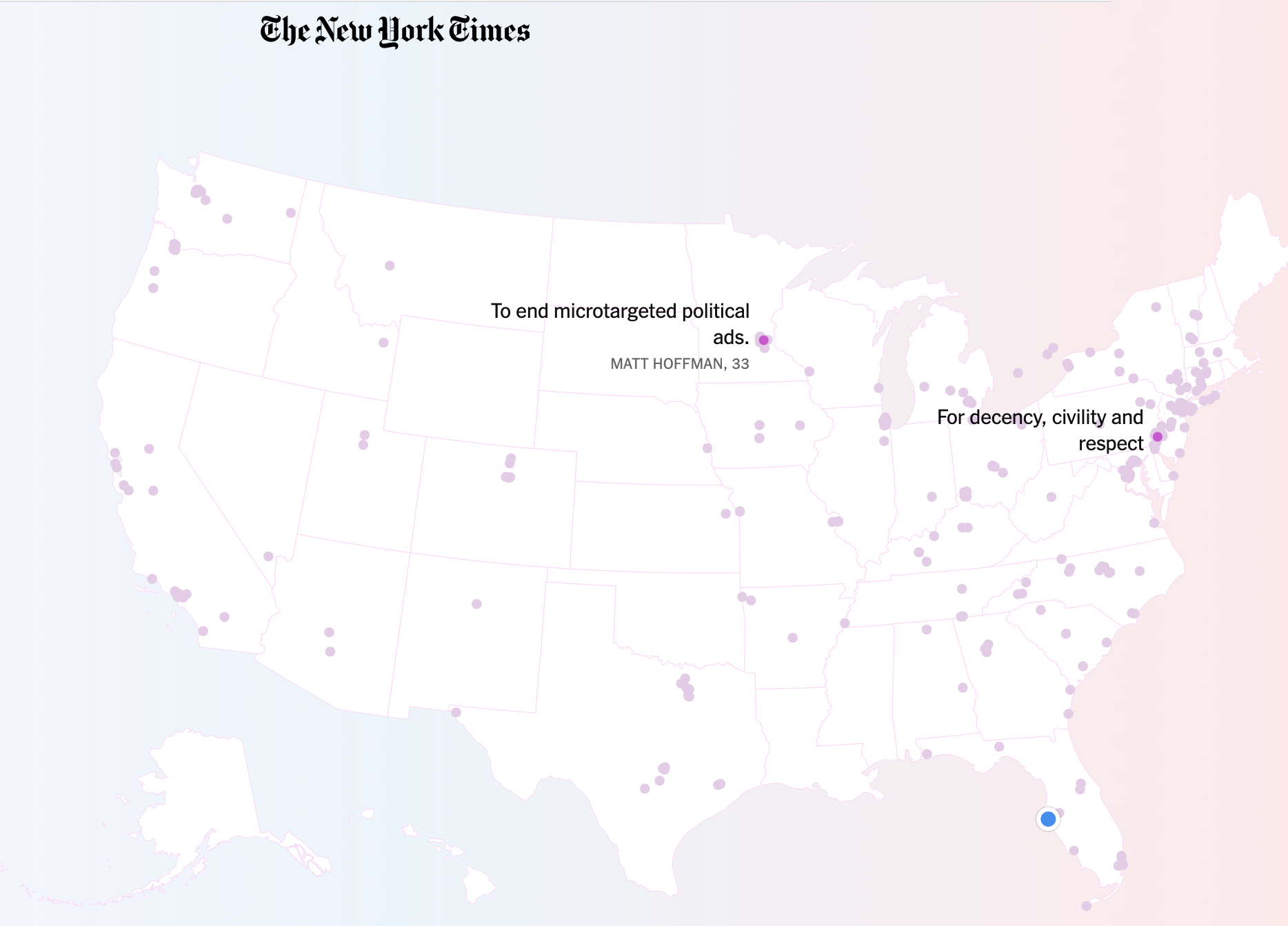
(Screenshot, The New York Times)
Here are some examples of what people are saying:
- To make America conservative again.
- To reject white supremacy.
- For the rights of women.
- To get the virus under control.
- For the future of humanity.
- To heal the divide.
- For my daughter’s future.
— AL TOMPKINS, Poynter Senior Faculty (2:31 p.m. Eastern)
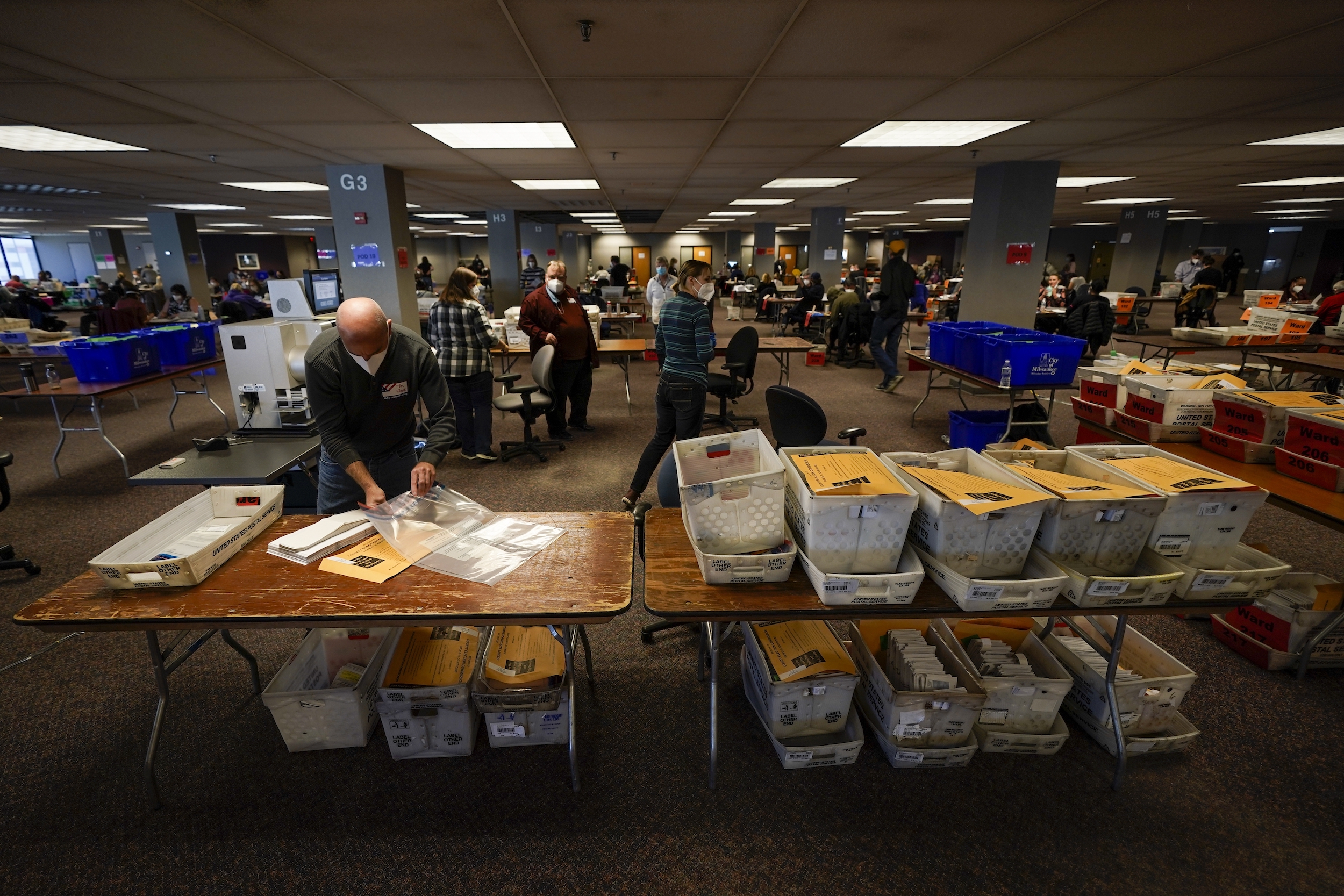
Workers count Milwaukee County ballots on Election Day at Central Count on Tuesday, Nov. 3, 2020, in Milwaukee. (AP Photo/Morry Gash)
Maybe all of the voter education that journalists did over the last few months is paying off. The New York Times said the rejection rate for early and mail-in ballots is down, way down, nationwide.
In Fulton County, Ga., home to Atlanta, just 278 of the first 60,000-odd ballots processed had been held back. In Minneapolis, Hennepin County officials last week had rejected only 2,080 of 325,000 ballots — and sent replacement ballots to all of those voters. In Burlington, Iowa, the number of rejected ballots on Monday was 28 of 12,310. And of 474,000 absentee ballots received in Kentucky, barely 1,300 rejects remain uncorrected by voters, compared to more than 15,000 during the state’s presidential primary in June.
In Florida, where 1.3 percent of mail ballots were thrown out in 2018, the rejection rate on Monday was a bare 0.3 percent. But “it’s not that we’re having fewer ballots rejected,” Daniel A. Smith of the University of Florida, said. “It’s that we’re having a higher rate of ballots being cured” — that is, corrected and made eligible for counting.
— AL TOMPKINS, Poynter Senior Faculty (2:20 p.m. Eastern)
Journalists who will be working late and whose newsroom won’t be sending food out tonight can still grab some free Election Day grub. Here are the best lists of free donuts, sandwiches, pizza, coffee and muffins we have found. And, obviously, you don’t need to be a journalist to take advantage of these:
— AL TOMPKINS, Poynter Senior Faculty (2:07 p.m. Eastern)

President Donald Trump speaks at the Trump campaign headquarters on Election Day, Tuesday, Nov. 3, 2020, in Arlington, Va. (AP Photo/Alex Brandon)
Just after 1 p.m. Eastern, President Trump spoke at Republican National Committee offices in Arlington, Virginia, and also took a few questions from the media. He thanked the RNC workers and told them, “I hear we’re doing well all over and I think we’re going to have a great night and, more importantly, a great four years.”
He said he felt his campaign gained momentum after the debates — especially the second one, he said — and recent rallies.
“I think we took off,” Trump said.
When asked how he felt, Trump said, “I feel very good.” He did admit his voice is “a little bit choppy” after holding so many rallies in the past few days.
He said he does not have an acceptance or concession speech prepared.
“Winning is easy, losing is never easy, not for me it’s not,” Trump said.
Trump also continued to tout his work on the economy, and repeated some of his go-to lines, such as that the coronavirus is “rounding the corner” and that he has done more for the African American community than any president except for Abraham Lincoln.
Afterward, CNN’s Don Lemon said, “I’m not sure we should be running this propaganda video as people are still going to the polls to vote today because not much of what he said about anything is true.”
CNN’s Erin Burnett said she felt Trump was toned down, saying, “For those who thought he was going to be bluster and bold and ‘I’m assured of victory’ and ‘I have my speech ready,’ he didn’t do that. … In a sense, he seemed a bit down. Maybe it’s just because he is tired. … I heard a change in tone there.”
— TOM JONES, Poynter Senior Writer (1:35 p.m. Eastern)
The news media plays a central role in calling U.S. elections. Poynter helps you make sense of all that coverage. Support our media reporting here.
Look to these outlets for live coverage of trending misinformation and fact checks today.
BuzzFeed News reporters Jane Lytvynenko and Craig Silverman are running a live blog featuring false and misleading information. The New York Times is tracking viral misinformation here. NBC News’ Brandy Zadrozny and Ben Collins are covering disinformation and extremist activity today. Snopes is updating its Election Day live blog with fact checks. PolitiFact, which is part of the Poynter Institute, will be combating misinformation, too.
And please, for the love of democracy, don’t spread misinformation. Pause before you hit the share button and cross-reference what you see by checking multiple sources. When you see a questionable claim, use the Stanford History Education Group’s three questions: Who is behind the information? What is the evidence? What are other sources saying?
— JAKE SHERIDAN, MediaWise Intern (1:22 p.m. Eastern)
NBC News correspondent Ken Dilanian, who covers covering national security and intelligence, reports:
So far there are no signs of voter intimidation, according to the ACLU, or significant foreign interference, according to cyber security firms and DHS. This is great news.
— Ken Dilanian (@KenDilanianNBC) November 3, 2020
— AL TOMPKINS, Poynter Senior Faculty (1:11 p.m. Eastern)
Some cities and counties are providing live video feeds of election workers counting votes.
The city of Philadelphia’s feed started at 7 a.m. Washoe County, Nevada, also lit up its livestream this morning.
Los Angeles County, the nation’s biggest voting district, is livestreaming four different views of the ballot processing. Maricopa County, Arizona, (Phoenix) is streaming 13 video feeds, covering the processes of signature verification, early ballot counting and ballot tabulation.
King County, Washington, (Seattle) offers livestream views of every step of its process — from sorting to verifying signatures on the outside, opening and reviewing ballots, and scanning and tabulating the votes.
Denver’s Election Ballot Processing Center is offering a live split-screen of all of the steps in its vote counting.
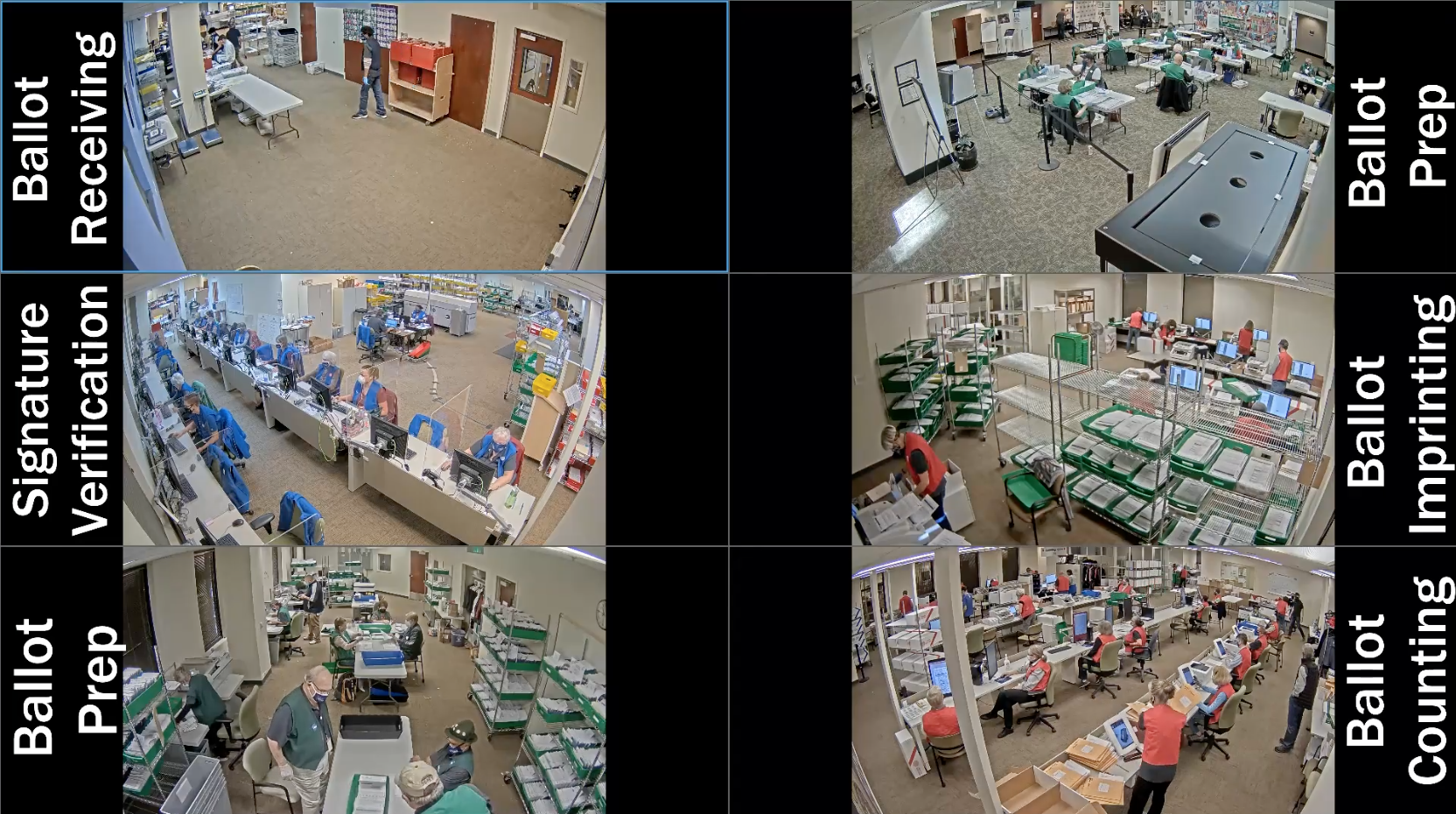
(Denver Election Ballot Processing Center)
Governing.com provided a collection of other live election cameras, including :
— AL TOMPKINS, Poynter Senior Faculty (1:06 p.m. Eastern)

A U.S. Postal Service truck makes deliveries next to the Supreme Court on Election Day, Tuesday, Nov. 3, 2020, in Washington. (AP Photo/J. Scott Applewhite)
Google Trends can offer really interesting insights about what people really want to know during a specific period of time and in a certain region of the world. Today, at 12:05 p.m. Eastern, Americans were eager to confirm what time the election would be on TV and who is predicted to win, but also something a bit curious for the digital age. People searched a lot about post offices this morning.
In the list of 10 rising search terms used on Google in the United States, questions regarding the mail service appeared twice. Between 3 a.m. and 9 a.m., there were hundreds of people searching to find out if the post offices were open, especially in Pennsylvania, Delaware, New Jersey and West Virginia.
CBS News reported yesterday that the U.S. Postal Service was seeing more delays in delivering the mail. “Last week about 20% of all letters and packages sent around the country in the week ended October 23 were late,” they reported. “Mail-in ballots, which are tracked separately by the Postal Service, are also taking longer in some swing states to reach election officials.”
But yes. Post offices are open this Tuesday and “the USPS is prioritizing ballot delivery,” CBS said.
FedEx and UPS are working, too. Today is not a federal holiday, so there is no need to worry. Your letter (and your ballot) will be delivered
— CRISTINA TARDÁGUILA, International Fact-Checking Network Associate Director (12:59 p.m. Eastern)
Cybersecurity experts have two big worries today, and so far, neither has come to life.
One worry, of course, is that online intruders, especially foreign actors, might attempt to interfere with the voting or vote totaling, or start online rumors about results.
Unlike 2016, when 28 million votes did not have a paper trail to back up computerized votes, only about 10 million votes will lack a backup this time.
NPR quoted Christopher C. Krebs, the director of the Department of Homeland Security’s cybersecurity arm, who said just a few days ago that he expects attackers to target election websites to either deface them or shut them down for a period of time. Hackers often use attacks like this to claim “capabilities that far exceed what they’re actually capable of,” Krebs said. These are sometimes referred to as “perception hacks,” since they allow an adversary to sow doubt about the vote totals without ever gaining the sort of access needed to actually change them.
Cybersecurity experts also worry that hackers will use the time when the United States is so focused on the election to hack accounts not related to the election. You can monitor the mind-boggling number of cyberattacks that are constantly underway around the globe on websites like CheckPoint, Cyware, Kaspersky, Fortiguard and Bitdefender.
Kevin Collier of NBC News said he didn’t have much to report on:
I’m a reporter assigned to look for cyber issues on Election Day. It’s been really boring so far.
— Kevin Collier (@kevincollier) November 3, 2020
— AL TOMPKINS, Poynter Senior Faculty (12:48 p.m. Eastern)
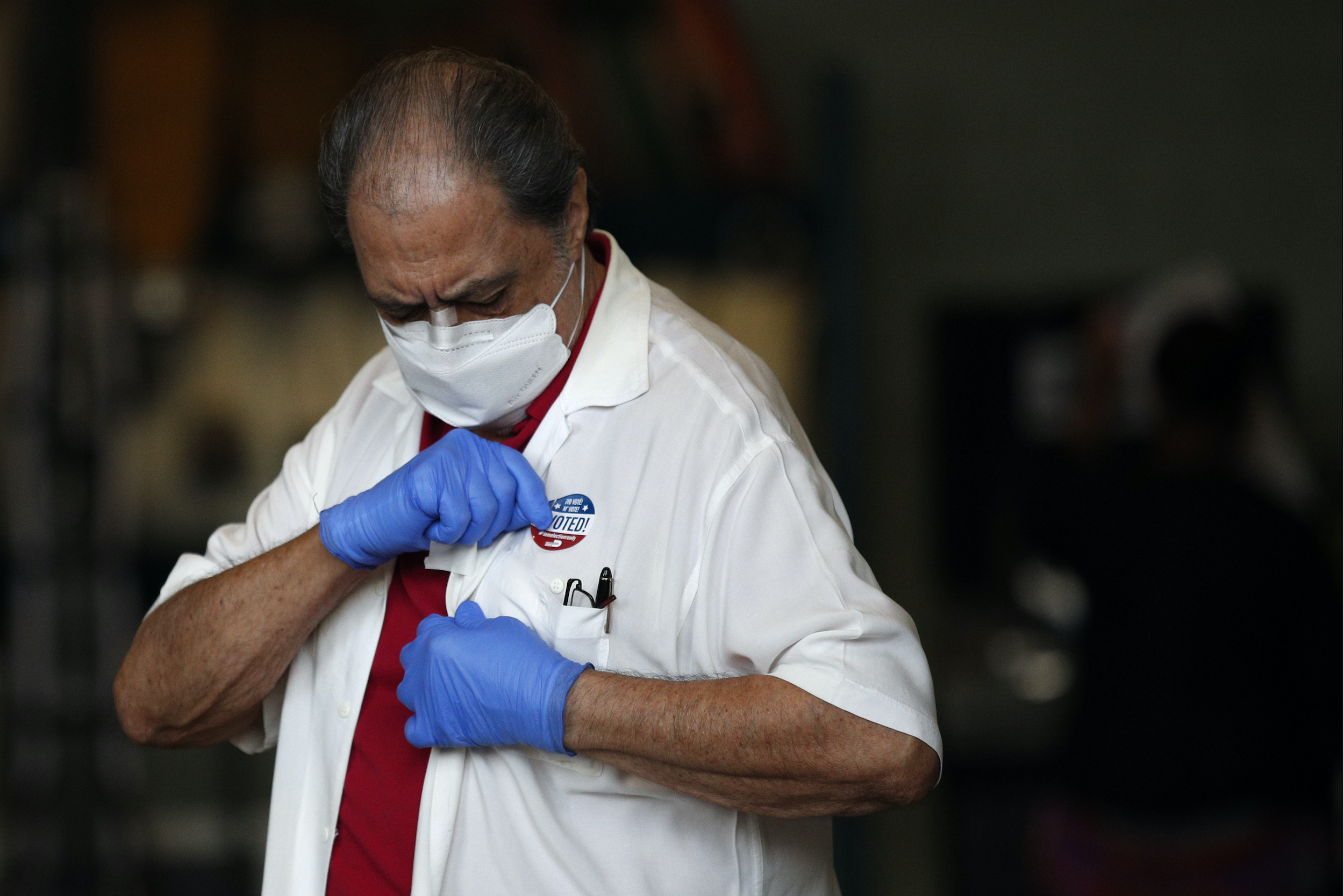
A man wearing gloves and a mask to protect against COVID-19 affixes an “I voted” sticker to his shirt as he leaves a polling place at Indian Creek Fire Station #4 in Miami Beach, Fla., on Election Day, Tuesday, Nov. 3, 2020. (AP Photo/Rebecca Blackwell)
Florida election supervisors say they have seen no shortage of poll workers today, which is something they feared in a pandemic.
In fact, some counties had so many poll worker applications they had to turn people away. NPR reported:
Heavy recruitment efforts unfolded, with nonprofits and celebrities such as NBA star LeBron James organizing young people to get trained on how to staff the polls. One such effort, called Power the Polls, set a goal of recruiting 250,000 new poll workers; it says more than 700,000 people signed up.
— AL TOMPKINS, Poynter Senior Faculty (12:09 p.m. Eastern)
On election night, delayed results could lead to speculation and guesses about outcomes. At Poynter, we lead with the facts, not bogus commentary or opinion. Support our fact-based election coverage here.
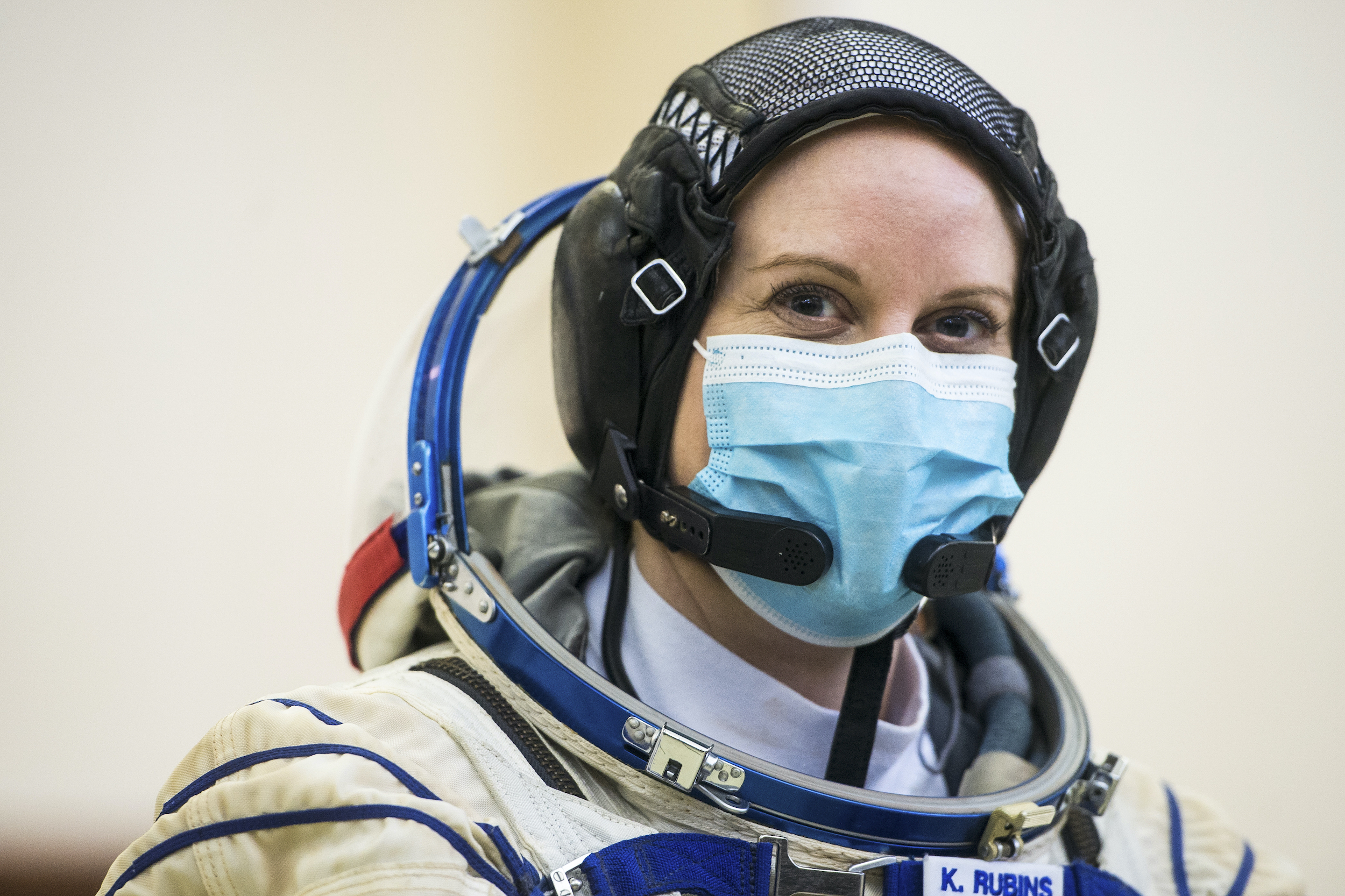
Expedition 64 crew member NASA astronaut Kate Rubins during Soyuz qualification exams Wednesday, Sept. 23, 2020 at the Gagarin Cosmonaut Training Center in Russia. Rubins told The Associated Press that she planned to cast her next vote from space — more than 200 miles above Earth. (NASA/GCTC/Andrey Shelepin)
Yes, Americans, you must vote today. And it’s not only because this is your best chance to be heard and to help decide the future of your country. The U.S 2020 presidential election is also registering impressive numbers and great stories. Did you know that astronauts are casting ballots from space? So why wouldn’t you go vote?
According to the U.S Election Project, the U.S. surpassed its early voting totals for the 2016 election back on Oct 22. When you woke up this morning, more than 21 million registered Democrats and more than 14 million Republicans had voted — just like more than 11 million Americans who have no party affiliation. You can’t stay out of it.
Texas and Hawaii have already surpassed their total 2016 voter turnout. North Carolina, Georgia and Florida have topped 90%. TV spending is off the charts, with $1.5 billion in presidential ad spending since April by candidates and groups, according to USA Today.
So go! Cast your ballot. Elections officials in at least 29 of the 33 states with mask mandates established that their rules would not prevent someone who refused to wear a mask from casting a vote. More than a dozen states say voters who refuse to wear a mask will have to follow special procedures, like filling out their ballot curbside or in an isolated area of a polling place away from other voters. But they should still vote.
Remember the next president will be sworn into office on Jan. 20, 2021. Today you have the chance to help choose if it’s going to be Donald Trump or Joe Biden.
During this Election Day, the International Fact-Checking Network will post dozens of uplifting messages based on electoral data on its social media channels. The goal is to show you how important it is to be part of this democratic journey. Follow @factchecknet on Twitter and share the facts.
— CRISTINA TARDÁGUILA, International Fact-Checking Network Associate Director (12:03 p.m. Eastern)
If you grow tired of traditional media Election Day coverage, here’s an alternative for you: “The Daily Show with Trevor Noah.” Noah will host a live one-hour episode called “Votegasm 2020: What Could Wrong? (Again).” It will air tonight at 11 p.m. Eastern (8 p.m. Pacific) on Comedy Central and be simulcast on MTV, MTV2, VH1, BET, BET Her and Pop TV. Guests will include actor and activist Don Cheadle and writer, sociologist and professor Dr. Tressie McMillan Cottom.
— TOM JONES, Poynter Senior Writer (11:50 a.m. Eastern)

Check out these front pages from papers outside the U.S. that led with our presidential election, plus a handful from around the country.
— KRISTEN HARE, Editor of Locally (11:45 a.m. Eastern)
President Donald Trump said he would “not play games” tonight and won’t declare victory if there is any doubt about the outcome of the election. The president told Fox & Friends he would claim a win “when there’s victory. If there’s victory.”
“I think we’ll have victory,” he said. “I think the polls are, you know, suppression polls. And I think we’ll have victory. But only when there’s victory. I mean, you know, there’s no reason to play games. And I think we’ll have victory.”
In the last week, the president and his team sent signals that the campaign might declare victory way ahead of news organizations making their projections.
— AL TOMPKINS, Poynter Senior Faculty (11:25 a.m. Eastern)
The Associated Press has a handy topical guide for election coverage and it includes some useful reminders. For example:
It’s Election Day and election night. “The first term is capitalized, the second is lowercase for the November national elections in the United States.”
It’s Electoral College and electoral votes. “The process by which the United States selects its president. The ‘college’ consists of 538 electors from the states. Each state gets as many electoral votes as it has members of Congress, and the District of Columbia gets three. To be elected president, the winner must get at least half the total plus one – or 270 electoral votes. Most states give all their electoral votes to whichever candidate wins that state’s popular vote. The electoral system has delivered a split verdict five times, most recently in 2016, with one candidate winning the popular vote and another the presidency.”
Avoid “head to the polls.” “Such a phrase does not account for the large number of voters who will cast a ballot before Election Day.”
— KRISTEN HARE, Editor of Locally (11:03 a.m. Eastern)
President Donald Trump greeted viewers of Fox and Friends on Election Day morning with a media critique about Fox News.
“It’s much different,” the president told hosts about the network compared with four years ago. Here’s BuzzFeed deputy breaking news director Stephanie McNeal with a clip from the back-and-forth:
Here’s Trump complaining about how much Fox News has had Joe Biden on the network and Fox and Friends’ awk responses trying to defend themselves 😬 pic.twitter.com/HgTgy8yhD4
— Stephanie McNeal (@stephemcneal) November 3, 2020
— KRISTEN HARE, Editor of Locally (10:58 a.m. Eastern)
So how is the early TV coverage going on the cable networks?
With Anderson Cooper anchoring, CNN has been traveling around the country to states such as Texas and Pennsylvania to check in on polling places. The network found there have been supporters of both candidates, particularly President Donald Trump, outside the polling stations, but so far, there have been no issues. Boisterous, yes. Loud? Yep. But respectful, too. CNN also had clips this morning of Joe Biden in Scranton, Pennsylvania.
Fox News’ “America’s Newsroom,” moderated by Sandra Smith, has been digging into the maps. Commentator Ari Fleischer bent himself into a pretzel to find a way for Trump to win. His scenario? Fleischer thinks Trump will win all the states he won in 2016 with the exception of Michigan and Wisconsin. That means he thinks Trump can (and will) win states that could go either way: Pennsylvania, Georgia, Florida, North Carolina, Texas and Ohio. In that case, Fleischer sees it all coming down to Arizona.
Over on MSNBC, Hallie Jackson spent time going over election day misinformation, as well as going to polling places around the country — such as in Ohio.
Speaking of MSNBC, did you happen to catch Monday night’s coverage? James Carville made a strong prediction. Yes, it’s important to note that Carville is a longtime Democrat strategist and certainly has a vested interest in the outcome, but not only did Carville predict a Joe Biden victory, but an easy Biden victory. Carville said he wouldn’t be surprised to see a call by 10:30 p.m. Eastern tonight.
So that’s where we are. Polls won’t close for several hours, but cable news has plenty of time to fill.
Pace yourself. It’s going to be a long day and night.
— TOM JONES, Poynter Senior Media Writer (10:57 a.m. Eastern)
Check back in to this live blog all day and night as we cover how the media is covering Election Day 2020.
"Media" - Google News
November 04, 2020 at 02:25AM
https://ift.tt/2I5H4ji
Live blog: How the media is covering the 2020 presidential election - Poynter
"Media" - Google News
https://ift.tt/2ybSA8a
https://ift.tt/2WhuDnP
Bagikan Berita Ini
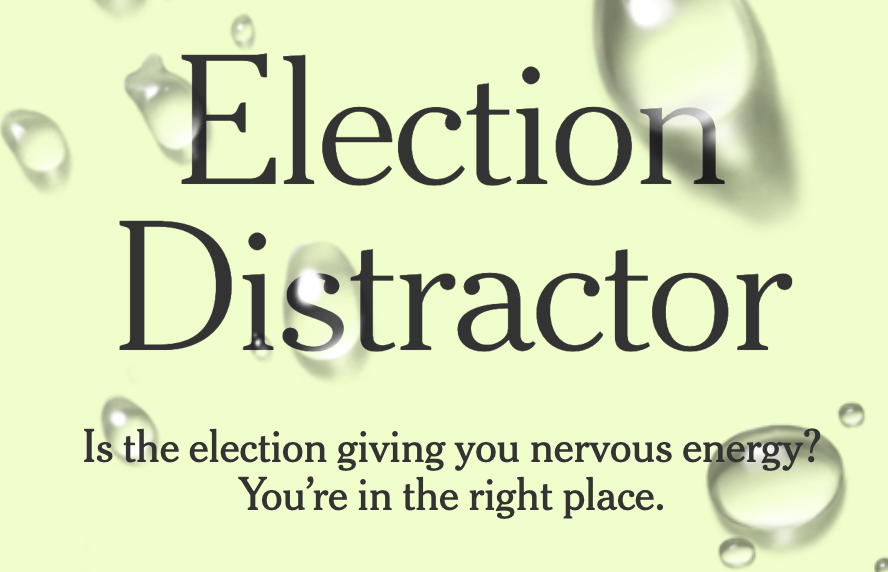














0 Response to "Live blog: How the media is covering the 2020 presidential election - Poynter"
Post a Comment